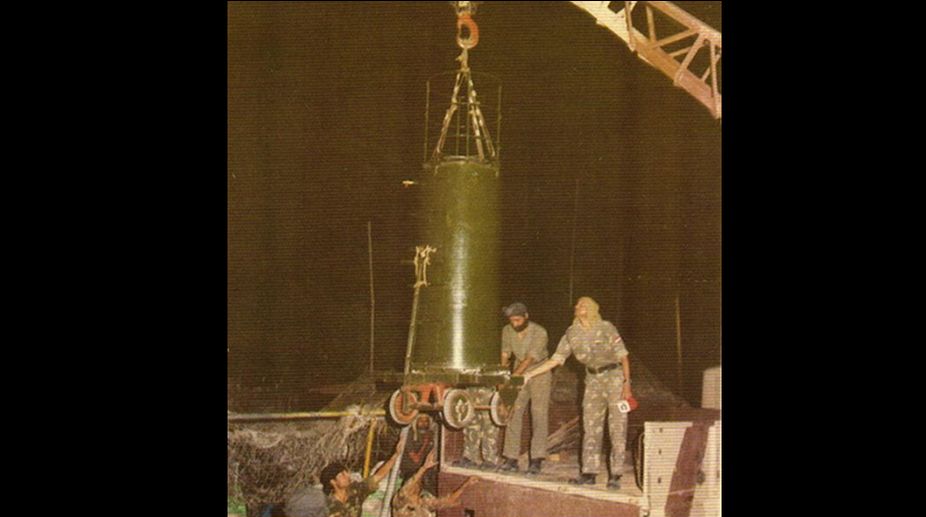NDA ‘s impressive show in UP, Raj, Bihar, Assam assembly bypolls
In another electoral battle between the NDA and the INDIA bloc, the NDA has put up an impressive show in Uttar Pradesh, Rajasthan, Bihar and Assam assembly bypolls.
Twenty years ago, Operation Shakti or Pokhran-II declared India as a nuclear state to the world. Pokhran-II, was a series of five nuclear bomb test explosions, conducted at the Indian Army’s Pokhran Test Range in Rajasthan.

Pokhran-II (Photo: Twitter)
After ‘Smiling Buddha’ (assigned code name of India’s first successful nuclear test) had put a smile on India’s face on 18 May 1974, India went on to herald a new dawn on it’s nuclear programme in May 1998 by successfully conducting Pokhran-II (Operation Shakti).
Twenty years ago, Operation Shakti or Pokhran-II declared India as a nuclear state to the world. Pokhran-II, a series of five nuclear bomb test conducted at the Indian Army’s Pokhran Test Range in Rajasthan, were accomplished even as the world’s major nuclear powers had imposed technological embargo on India.
#Pokhran2 #ThisDayThatYear We salute the contributions of all the team members of ‘Op Shakti’ on the occasion of National Technology Day @IAF_MCC @adgpi @SpokespersonMoD@DefenceMinIndia @BARCIndia @DAEIndia @DRDO_India @nsitharaman pic.twitter.com/phVuahJO3R
Advertisement
— SpokespersonNavy (@indiannavy) May 11, 2018
WHAT WAS POKHRAN-II?
Pokhran-II was the series of five nuclear bomb test explosions conducted by India at Rajasthan’s Indian Army’s Pokhran Test Range in May 1998. It was the second Indian nuclear test; the first test, code-named Smiling Buddha, was conducted in May 1974.
Pokhran-II consisted of five detonations, of which the first was a fusion bomb and the remaining four were fission bombs. These nuclear tests resulted in a variety of sanctions against India by a number of major states, including Japan and the United States.
HERE’S HOW INDIA BEGAN ITS JOURNEY ON A NUCLEAR PATH:
1962: War began between India and China. India lost more than 4,000 soldiers in the war.
1974: After China conducted its first nuclear test (in 1964) India under the leadership of Prime Minister Indira Gandhi, became the 6th country to join the nuclear club with India’s first successful nuclear test, Pokhran-I or Smiling Buddha.
1996: Prime Minister Atal Bihari Vajpayee gives a go ahead for nuclear tests after coming to power but his government collapsed two days later.
March 1998: Atal Bihari Vajpayee took oath as the 13th Prime Minister of India and secretly meet Dr APJ Abdul Kalam (the then DRDO chief), Dr R Chidambaram (the then Atomic Energy Chief), Dr Anil Kakodkar (the then BARC Chief), Brajesh Mishra (the then NSA) and LK Advani (the then Home Minister) at South Bloc.
April 1998: After a second secret meet, PM Vajpayee gives another go-ahead for the nuclear tests.
May 1998: The equipment for nuclear test was flown from the Bhabha Atomic Research Centre to Jaisalmer Airport. Under the command of Col Umang Kapur the equipment was later moved in four Army trucks to the location of the test.
11 May 1998: Under operation Shakti, three nuclear bombs were detonated
13 May 1998: Two additional bombs were detonated
LIST OF FIVE NUCLEAR DEVICES DETONATED DURING OPERATION SHAKTI:
After Pokhran-II, countries like Canada and Japan imposed sanctions on India and freezed the allocation of humanitarian aid to India. However, the effect of international sanctions on Indian economy were minimal, as most of the nations did not call for embargoes against India.
11 MAY COMMEMORATED AS NATIONAL TECHNOLOGY DAY
So much was the importance of the nuclear test in Indian viewpoint, that later 11 May was commemorated as National Technology Day.
With India achieving a major technological breakthrough by successfully carrying out nuclear tests at Pokhran. Also first, indigenous aircraft “Hansa-3” was test flown at Bangalore on this day and India also performed successful test firing of the Trishul missile on the same day.
Considering the technological achievements on a particular date, 11 May, the day was chosen to be commemorated as National Technology Day.
Also read | President Kovind hails Kalam, Atal Bihari Vajpayee for Pokhran
IN POPULAR CULTURE
John Abraham-starrer film, “Parmanu-The Story of Pokhran”, will be released on 25 May. The film explores the story of the secretive nuclear test conducted by India at Pokhran in 1998.
Also read | Parmanu trailer: Story of how nuclear India took birth
Advertisement